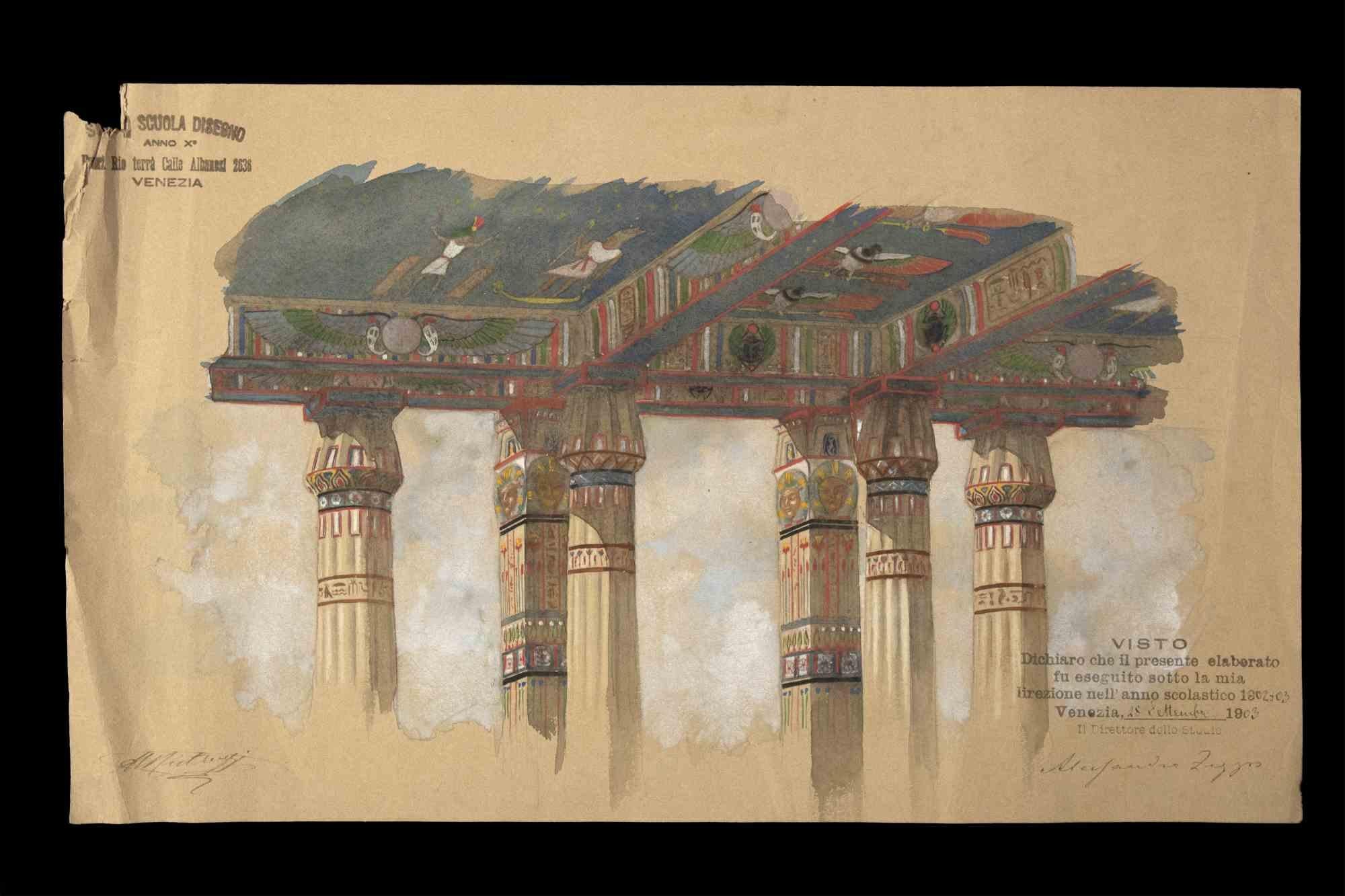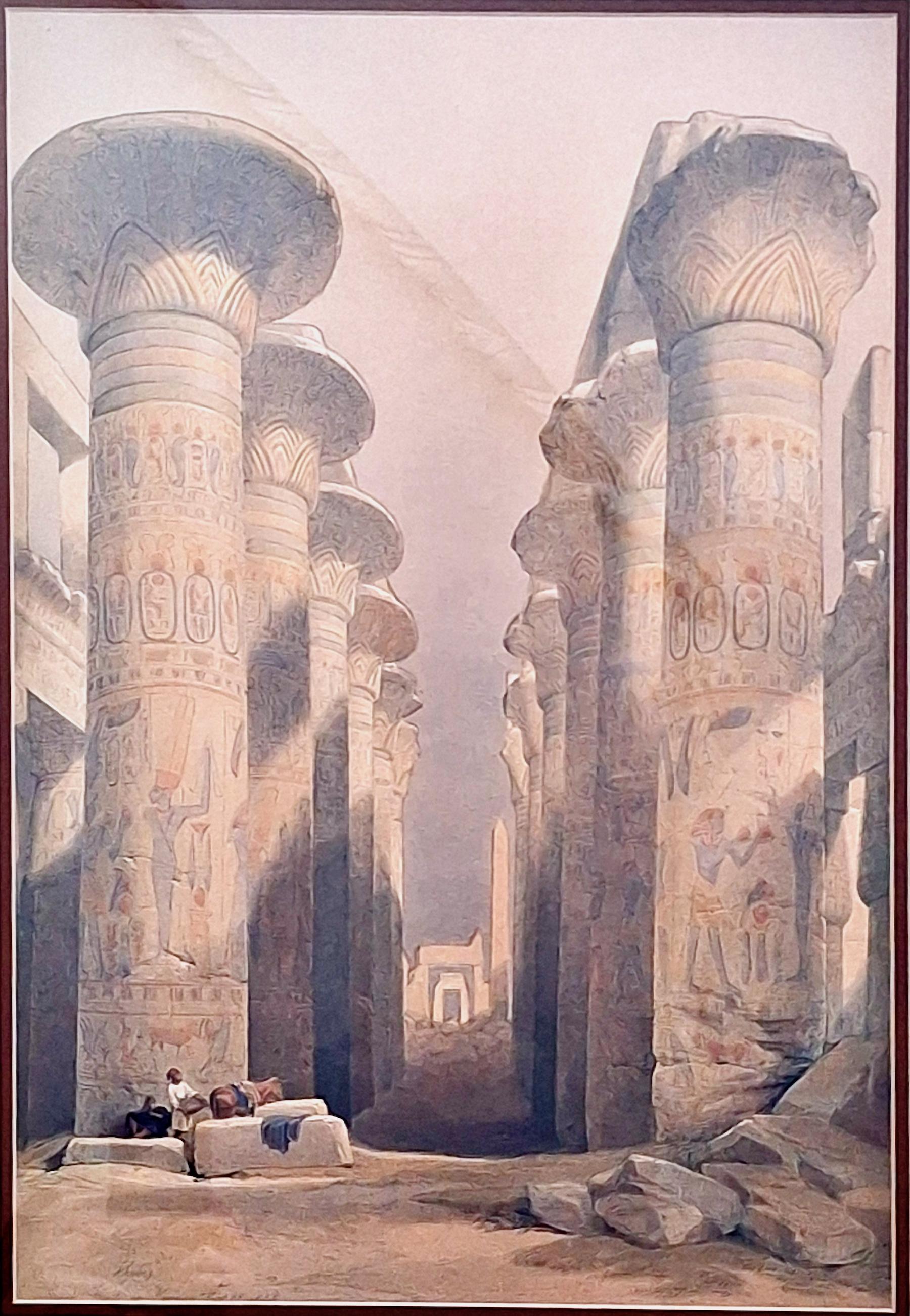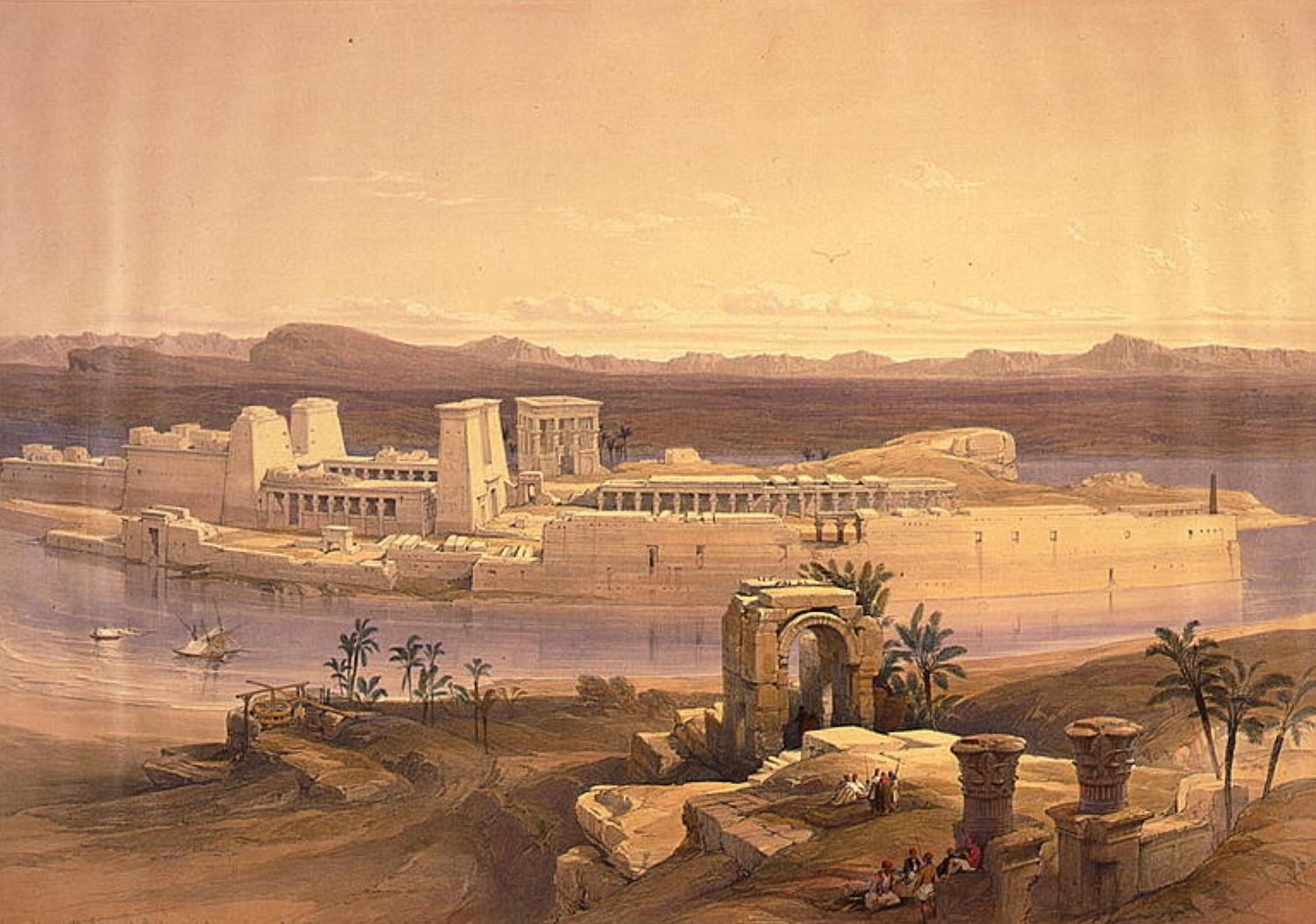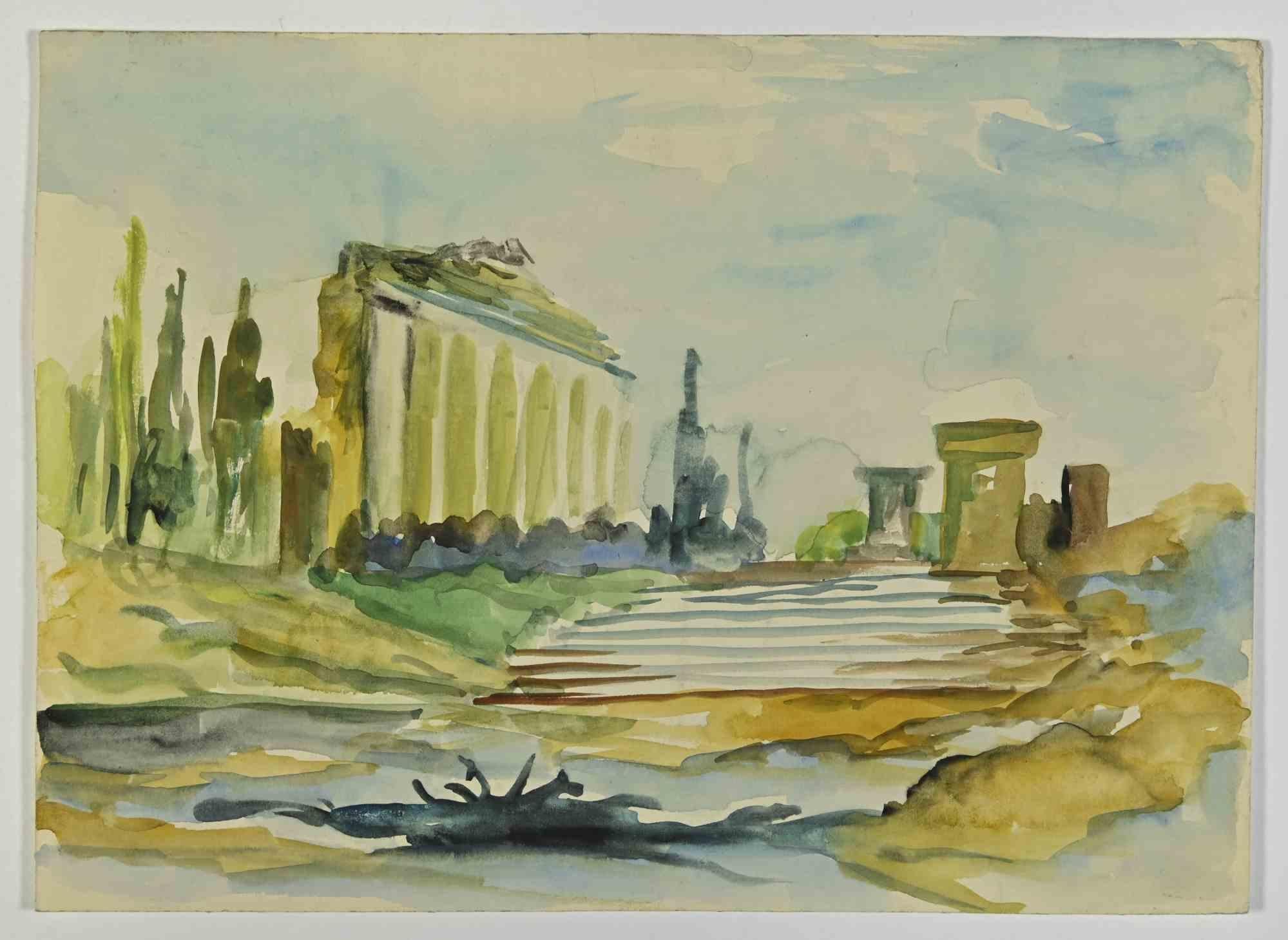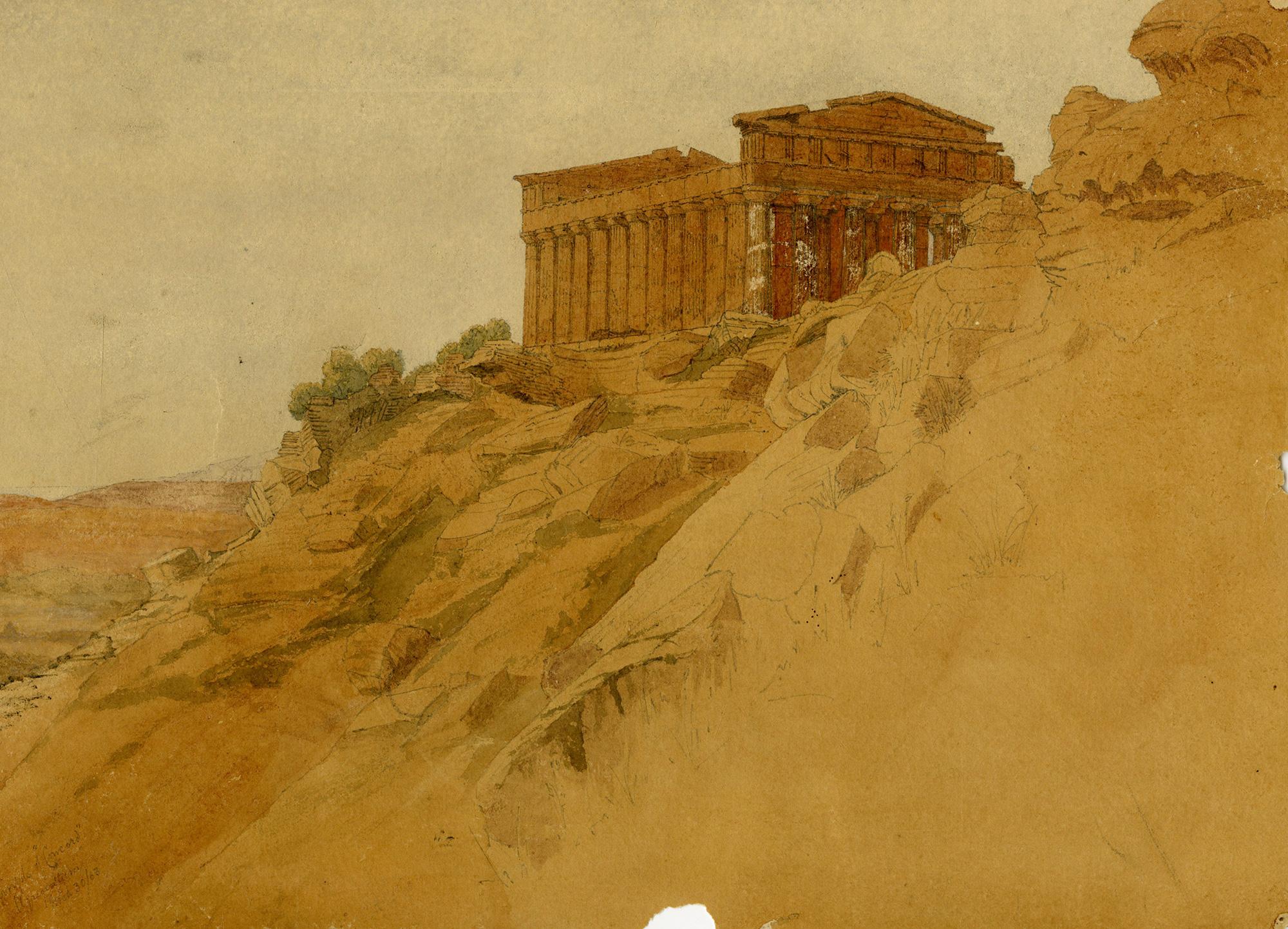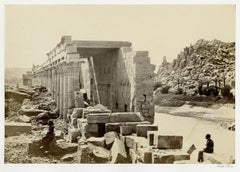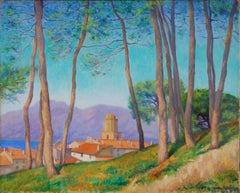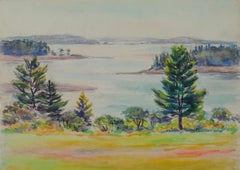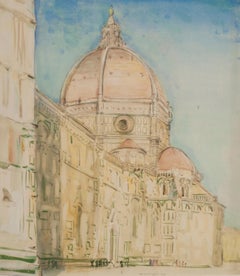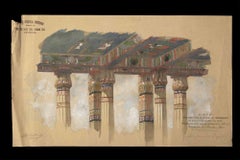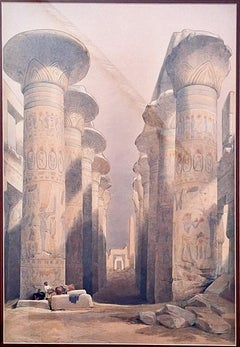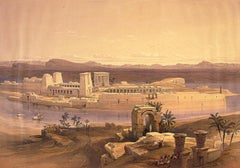Items Similar to Temple of Isis, View of Philae (verso)
Want more images or videos?
Request additional images or videos from the seller
1 of 15
Henry BaconTemple of Isis, View of Philae (verso)1902
1902
$3,500
£2,658.82
€3,061.62
CA$5,007.10
A$5,492.31
CHF 2,832.18
MX$65,600.18
NOK 35,920.63
SEK 33,697.62
DKK 22,879.42
About the Item
Temple of Isis
Philae (verso)
Dpouoble sided watercolor, 1902
Signed on front lower left: "Henry Bacon" and dated 1902
Note:
The Temple of Isis is located on the Island of Philae at the first Cataract of the Nile River. It has been a major religious site of the Egyptians, Greeks and Romans. The Temple of Isis is a Roman temple dedicated to the Egyptian goddess Isis. Isis was a goddess in Ancient Egyptian religious beliefs, whose worship spread throughout the Greco-Roman world. She was worshipped as the ideal mother, wife, the matron of nature and magic.
Provenance:
Estate of the Artist
The Artist's Sister in Law
By decent
Note: Bacon exhibited at the salon from 1868 through to 1896 with genre works which had found favor with the American market. He also worked as a journalist sending reports of events in Paris to the Boston Daily Evening Transcript. In 1897, he travelled to Egypt for the first time and began regularly spending Winters there. At that time, he switched from oils to watercolors which he believed was the optimal medium to capture the transparent light of the Middle East.
(Courtesy of Wikipedia)
Temple of Isis (recto)
Built during the reign of Ptolemy II (Egypt’s Greco-Roman Period), the Temple of Isis at Philae is dedicated to Isis, Osiris, and Horus. The temple walls contain scenes from Egyptian mythology of Isis bringing Osiris back to life, giving birth to Horus, and mummifying Osiris after his death.
The temple was in danger of being submerged forever with the construction of the new Aswan dam (1960-1970), which flooded the area. Fortunately, the Egyptian government and UNESCO worked together to pump the area dry and relocate the entire temple, stone by stone (50,000 stones!), to a nearby island called Agilka, where it stands today.
Philae (verso)
An island was located near the First Cataract of the Upper Nile. It was flooded by the fist or Lowe Aswan Dam of 1902. It was further submerged by the new Aswan Dam of 1960-1970.
The ancient Egyptian name of the smaller island meant "boundary". As their southern frontier, the pharaohs of Egypt kept there a strong garrison, and it was also a barracks for Greek and Roman soldiers in their turn.
- Creator:Henry Bacon (1832 - 1912, American)
- Creation Year:1902
- Dimensions:Height: 13 in (33.02 cm)Width: 18 in (45.72 cm)
- Medium:
- Movement & Style:
- Period:
- Condition:
- Gallery Location:Fairlawn, OH
- Reference Number:Seller: FA92341stDibs: LU14012989102
About the Seller
5.0
Recognized Seller
These prestigious sellers are industry leaders and represent the highest echelon for item quality and design.
Platinum Seller
Premium sellers with a 4.7+ rating and 24-hour response times
Established in 1978
1stDibs seller since 2013
815 sales on 1stDibs
Typical response time: <1 hour
Associations
International Fine Print Dealers Association
- ShippingRetrieving quote...Shipping from: Fairlawn, OH
- Return Policy
Authenticity Guarantee
In the unlikely event there’s an issue with an item’s authenticity, contact us within 1 year for a full refund. DetailsMoney-Back Guarantee
If your item is not as described, is damaged in transit, or does not arrive, contact us within 7 days for a full refund. Details24-Hour Cancellation
You have a 24-hour grace period in which to reconsider your purchase, with no questions asked.Vetted Professional Sellers
Our world-class sellers must adhere to strict standards for service and quality, maintaining the integrity of our listings.Price-Match Guarantee
If you find that a seller listed the same item for a lower price elsewhere, we’ll match it.Trusted Global Delivery
Our best-in-class carrier network provides specialized shipping options worldwide, including custom delivery.More From This Seller
View AllThe Colonnade, Island of Philae
By Francis Frith
Located in Fairlawn, OH
The Colonnade, Island of Philae
Original gold toned albumin photograph, c. 1862
Unsigned as is usual
From: Upper Egypt and Ethiopia, c. 1862, Vol 1, (36 plates)
Published by William ...
Category
1860s Romantic Landscape Photography
Materials
Photographic Paper
The Port of San Tropez
By Alexander L. Warshawsky
Located in Fairlawn, OH
The Port of San Tropez
Oil on canvas, c. 1920
Signed lower right corner (see photo)
Condition: Excellent, professionally cleaned
Image/Canvas size: 25 3/4 x 32 inches
Frame size: 30...
Category
1920s American Impressionist Landscape Paintings
Materials
Oil
untitled (Mt. Desert Narrows)
By Greta Allen
Located in Fairlawn, OH
untitled (Mt. Desert Narrows)
Watercolor on paper, c. 1945-1955
Unsigned
Provenance: Estate of the Artist
Condition: Excellent
Image/sheet size: 11 1/4 x 15 3/8 inches
Regarding the ...
Category
1940s American Impressionist Landscape Drawings and Watercolors
Materials
Watercolor
The Duomo, Florence
By Donald Shaw MacLaughlan
Located in Fairlawn, OH
The Duomo, Florence
Watercolor, 1914
Signed and dated lower center edge (see photo)
Florence Cathedral, formally the Cattedrale di Santa Maria del Fiore, is the cathedral of Florence, Italy. It was begun in 1296 in the Gothic style to a design of Arnolfo di Cambio and was structurally completed by 1436, with the dome engineered by Filippo Brunelleschi.
Condition: Excellent
Image size: 16 3/4 x 14 1/2 inches
Frame size: 24 1/4 x 22 inches
Donald Shaw MacLaughlan was born in Charlottetown, Prince Edward Island, Canada on November 9, 1876. His family moved to Boston, Massachusetts in 1890 where he began to experiment with different art media; watercolor, oil painting and finally, etching – with a few attempts at lithography. He spent much of his early years at the Boston Public Library studying the work of printmakers, from Durer and Rembrandt to the 18th century English, French and Italian masters.
Like many American artists of the time MacLaughlan traveled to Europe to study in Paris, enrolling in the Ecole des Beaux Arts and studied further with Jean Leon Gerome and Jean Paul Laurens. In 1899 he began producing etchings, which became his major interest until his death in 1938. He became acquainted with James NcNeill Whistler (1834-1903) and other artists who created etchings and spent time studying the etchings of Rembrandt van Rijn (1606-1669) and other old masters in the collection of the Bibliothèque Nationale. Both Rembrandt and Whistler would have major influences on his art. In 1900 he created a set of 25 etched views of Paris and in 1901 exhibited two etchings in the Salon de la Société Nationale des Beaux-Arts. He returned to the U.S. in 1903, then went back to Paris the following year.
He traveled extensively in Europe, visiting England, Switzerland, Italy and Spain as well as various locales in France. His etched views of Venice were well-known. MacLaughlan exhibited views of Paris, Rouen, Normandy and Italy in 1906 in a solo show at the American Art Association Galleries in Paris. He also displayed his work in the 1906 exhibitions of the Société Nationale des Beaux-Arts and the Société des Peintres-Graveurs Français. MacLaughlan even instructed other expatriate Canadian artists then living in Paris, most notably Clarence...
Category
1910s American Modern Landscape Drawings and Watercolors
Materials
Watercolor
Doorway in the Temple of Kalabshe, Nubia
By Francis Frith
Located in Fairlawn, OH
Doorway in the Temple of Kalabshe, Nubia
Original gold toned albumin photograph, c. 1862
Unsigned as is usual
From: Upper Egypt and Ethiopia, c. 1862, Vol 1, (36 plates)
Published by...
Category
1860s Romantic Landscape Photography
Materials
Photographic Paper
Ponte Vecchio Florence
By Robert Hallowell
Located in Fairlawn, OH
Ponte Vecchio Florence
Oil on canvas, 1927
Signed and dated lower right corner
Titled upper left
NOTE: this offering is UNFRAMED
Condition: Excellent
Conservation by Monica Radecki, ...
Category
1920s American Impressionist Landscape Paintings
Materials
Oil
You May Also Like
Sketch of Egyptian Temple - Original Pastel Drawing - Early 20th Century
Located in Roma, IT
Sketch of Egyptian Temple is an original drawing in watercolor and Ink realized by an anonymous artist in the early 20th Century.
Good conditions except ...
Category
Early 20th Century Modern Figurative Drawings and Watercolors
Materials
Pastel
“Thebes, Great Hall at Karnak”
By David Roberts
Located in San Francisco, CA
This lithograph titled "Thebes, Great Hall at Karnak" is a notable work by the Scottish painter David Roberts (1796-1864). This particular scene is part of Roberts' most famous colle...
Category
1840s English School Landscape Prints
Materials
Paper, Lithograph
View From Under The Portico of The Temple of Edfou, Upper Egypt
By David Roberts
Located in London, GB
David Roberts R.A.
1796 - 1864
VIEW FROM UNDER THE PORTICO OF THE TEMPLE OF EDFOU, UPPER EGYPT
First edition lithograph available
Full plate: 157
Presented in an acid free mount
We have in stock a full set of the David Roberts lithographs...
Category
Mid-19th Century Landscape Prints
Materials
Lithograph
General View of the Island of Philae, Nubia
By David Roberts
Located in London, GB
General View of the Island of Philae, Nubia
Subscription and first edition lithographs in stock
Full plate: 151
Presented in a acid free mount
£2080
Scroll down for more information....
Category
19th Century Victorian Landscape Prints
Materials
Lithograph
Ancient Ruins - Drawing by Marcel Guillard - Early 20th century
Located in Roma, IT
Ancient Ruins is a drawing in Watercolor realized by Marcel Guillard (1896-?) in the early 20th Century.
Good condition.
Category
Early 20th Century Modern Figurative Drawings and Watercolors
Materials
Watercolor
The Temple of Concordia, Agrigento - English School drawing, 19th Century
Located in Middletown, NY
A lovely grand tour image of the Doric architectural masterpiece dedicated to Castor and Pollux.
Dated 1863.
Watercolor and graphite on lightweight card stock, 10 x 13 3/4 inches (2...
Category
Mid-19th Century English School Landscape Drawings and Watercolors
Materials
Watercolor, Cardboard, Graphite
